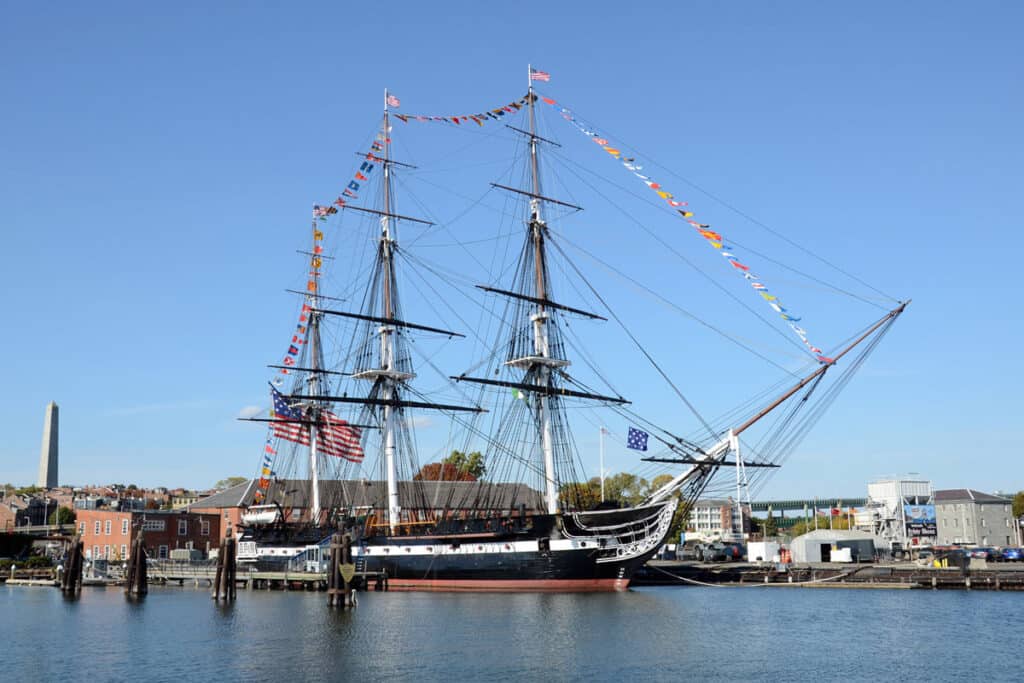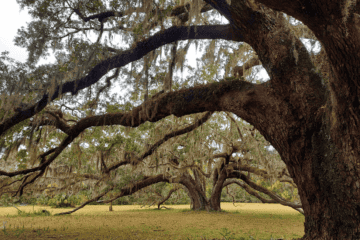Stayin’ Alive: Exploring the Southern Live Oak

Arbor Day arrives the end of April, and whether you observe this holiday or not, there is a majestic local tree worth celebrating: the live oak. Appreciated for centuries as a reliable building product, today it is simply adored as an iconic symbol of the South. Below we explore basic facts and historic uses of this beloved Southern tree.
As their scientific name of Quercus virginiana suggests, southern live oaks are found from Virginia south to Florida and Cuba and west to Texas and Oklahoma. They are deemed “live” for two reasons: first, because unlike most oak trees which are deciduous, southern live oaks are nearly evergreen, replacing their leaves over several weeks in the spring, and second, because when lumbered or injured, live oaks send up many sprouts which themselves produce sprouts if cut.
Live oaks are impressive in part due to their imposing stature; the largest live oaks can reach up to 60 feet in height with their crowns’ obtaining a diameter of 150 feet, the length of half a football field. Their trunks may grow to five or six feet in diameter and their branches extend horizontally up to two or three times the height of the tree.

In centuries past, the live oak was prized as a shipbuilding material for several reasons: it is very strong and dense, among the heaviest of American woods; it is resistant to rot and disease; and it has a particular grain which creates enormous strength for supporting weight and pressure. This strength, along with the branches’ natural curvature, made this wood ideal for the interior hulls of ships. In fact, Secretary of War James McHenry claimed ships built of live oak and cedar were five times more durable than those built of common white oak.
A notable warship employing live oak is the USS Constitution, or “Old Ironsides,” built in 1797 with an interior hull of live oak harvested from St. Simons Island and Cumberland Island. The ship earned its nickname in the War of 1812 after a British frigate shot at it with cannonballs which simply bounced off the ship’s oak sides.

Old Ironsides’ victory proved live oak to be an ideal material for warship construction and prompted President John Quincy Adams to initiate the naval Live Oak Tree Reservation Program. In 1828, the first and only national tree farm, the Naval Live Oak Reservation, was established in present-day Gulf Breeze, Florida, and by 1831, the United States controlled most large groves for the building and maintaining of navy warships, creating a virtual monopoly on the supply of live oaks. However, the Civil War marked the end of wooden warships, as steam replaced sails and metal replaced wood.
Today, the southern live oak is appreciated as a shade tree and avenue tree as well as a habitat for many creatures in the southern United States. The threatened Florida scrub-jay relies on the scrub form of the southern live oak for nesting, while other birds make use of the Spanish moss that frequently hangs from tree branches to construct nests. Live oaks’ acorns fall in the autumn and serve as a food source for many birds and mammals including mallards, wild turkeys, squirrels, black bears, and deer.

You, too, can plant your own live oak tree to enhance the natural beauty of our area. This tree is easy to grow and maintain: while it prefers a minimum of four hours of direct, unfiltered sunlight each day, it is highly adaptable to many different types of soil. In addition, it can tolerate salt spray and has superior wind resistance, although it does not handle freezes very well (it is Southern, after all).
These trees are fast-growing when young, reaching close to their maximum trunk diameter within 70 years. And of course, the tree you plant could live centuries; although their life span is generally around 300 years, the oldest live oaks are estimated to be between several hundred to more than one thousand years old.
So why not celebrate Arbor Day this year by planting the iconic live oak tree? Maybe the sapling you plant could become a venerable oak at which future generations marvel just as we do our local centuries-old trees.
Learn more about the live oak and its important history on our Cumberland Island and St. Marys Walking Tours!


